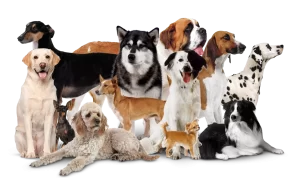As a dog owner, you must ensure your furry friend gets a healthy balanced diet. A good and nutritious diet influences a dog’s health, energy, and general well-being highly. However, the wide variety of food products available can be confusing when it comes to choosing the best food for your dog. This comprehensive guide will help you navigate the world of dog nutrition, understand what to look for in dog food, and provide tips for making the best choices for your pet.
Table of Contents
ToggleUnderstanding Dog Nutrition
To select the food options most suited for your pet, it is important first to learn a little about what makes up the basics of a good diet. A great balanced meal has many of the following:
1. Proteins
Proteins are necessary for growth and development and maintaining muscle. If your dog does not receive enough protein in his diet, he will suffer greatly, but they were designed to succeed on sources of high-quality protein such as:
Meat: Chicken, beef, lamb, fish
Eggs: High amino acids and very digestible
Plant-based proteins: Lentils and peas may be used as a good supplemental protein source in some diets.
2. Fats
Healthy fats provide essential fatty acids, which are crucial for the maintenance of healthy skin and coat, brain function, and energy. Look for:
• Animal fats: Chicken fat or fish oil will contain omega-3 and omega-6 fatty acids.
• Vegetable oils: Canola or flaxseed oil are a good source of healthy fats.
3. Carbohydrates
While dogs are nominally carnivorous, carbohydrates will provide energy and help to support digestion. Where possible, choose whole grain and vegetable sources, such as:
– Brown rice
– Oats
– Sweet potatoes
– Carrots
4. Vitamins and Minerals
Vitamins and minerals play many roles in the body, from immune function to bone strength. A well-balanced dog food should include:
– Vitamins A, C, D, E, and B-complex
– Calcium and phosphorus to maintain healthy bones
– Zinc and iron for immune support
How to Read Dog Food Labels
To make smart choices, you have to know how to read dog food labels. Here are some key terms and what to look for:
1. AAFCO Statement
AAFCO, the Association of American Feed Control Officials, is in charge of nutritional guidelines for pet foods. You ought to find a statement declaring the food meets AAFCO guidelines for your dog’s life stage: puppy, adult, or senior.
2. Ingredient List
Ingredient List: This list shall include the ingredients in decreasing order by weight. High-quality protein sources should be listed first. Avoid words that have such as “meat by-products” or “animal digest.”
Guaranteed Analysis
Guaranteed analysis is nutrient content information which includes percentages of protein, fat, fiber, and moisture. It will ensure these percentages meet your dog’s needs.
Feeding Guidelines
Most of the dog food bags contain a feeding guide according to the weight of your dog and the level of activity it has. Consider those as a base and you can adjust it according to your dog’s specific needs.
Types of Dog Food
There are different types of dog food. Each has some pros and cons:
1. Dry Dog Food (Kibble)
Advantages:
Conveniences to feed, inexpensive, and can prevent much dental plaque formation.
– Cons: Usually uses less healthy ingredients and is not as appetizing to fussy eaters.
2. Wet Dog Food (Canned)
– Pros: Better tasting and easier on the gut. Best for dogs with dental problems.
– Cons: More expensive and can cause dental issues if only fed.
3. Raw Dog Food
– Pros: It mimics the diet that dogs would naturally have in the wild and can bring improvements in coat condition, energy levels, and overall health.
– Cons: Must be dealt with precariously to avoid contamination by bacteria, and may not provide the necessary nutrients if prepared unbalanced.
4. Home-Cooked Meals
– Pros: Total control over what will be fed and can be customized to an animal’s needs.
– Cons: Time-intensive and great detail must be used to ensure the right balance.
Choosing the Right Dog Food
When it comes time to select the best possible food for your dog, the following should be considered:
1. Life Stage
Choose food formulated for your dog’s life stage:
– Puppies: Higher levels of protein and fat for growth and development.
– Adults: Balanced nutrition to maintain health.
– Seniors: Lower calories and supplements designed to help joints.
2. Breed Size
However, some breeds have different needs when it comes to nutrients. Large dogs will need large dog food because their food can affect growth issues. Other small breeds may require more calories to keep up with the energy level.
3. Health Conditions
If your dog has special health conditions like allergies, too fat, or diabetes, have it checked with your veterinarian who might prescribe a special diet for it.
4. Taste Preferences
Picky eaters can be tedious when it comes to mealtimes. Just try different brands, flavors, and textures to discover what your dog’s favorite is.
Switching Dog Food
The food for your dog should be changed gradually. If there is a sudden change, then it can cause shock to the sensitive gastrointestinal system of the dog. Here’s how to do it:
1. Day 1-2: 25% new food:75% old food
2. Day 3-4: 50% new food:50% old food.
3. Days 5-6: Feed 75% of new food mixed with 25% of old food.
4. Day 7: Feed 100% new food.
Monitor your dog for signs of distress or allergy while transitioning the food.
Dog Food Myths
1. Grain-Free is Always Better
Some dogs are allergic to grains, but many dogs digest grains with no problems at all. Grain-free is not necessarily better and can lead to imbalances in nutrients if not balanced.
2. Raw Diets are the Best Option
Raw diets can be very beneficial for some dogs, but they require special treatment as well as balanced nutrition. Always consult your vet before you make such a drastic change in diet.
3. Human Food is Always Bad for Dogs
Some human foods are poisonous to dogs-these which include chocolate, onions, etc. Still, most fruits and vegetables are safe and very healthy boosts to a dog’s diet. Always check with your vet before giving your dog bits of certain human foods.
Conclusion
The best food for your dog is one of the top things that describe a responsible owner of a pet. Understanding how to interpret nutritional requirements, reading food labels, and ensuring that you have selected premium quality ensures that your furry friend enjoys a long, healthy, and active life. Always call your veterinarian to personally know what would best suit your dog.
For more similar info:·
https://chimacumvet.com › Dog-nutrition
































